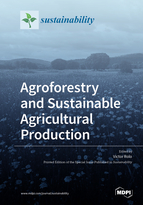Agroforestry and Sustainable Agricultural Production
A special issue of Sustainability (ISSN 2071-1050). This special issue belongs to the section "Sustainable Agriculture".
Deadline for manuscript submissions: closed (15 June 2022) | Viewed by 33520
Special Issue Editor
Special Issue Information
Dear Colleagues,
Our ability to feed the future world population with the current agriculture production practices is being questioned. Intensification has been the usual option of modern agriculture, but it still has a limited potential to meet the increasing food demand. In addition, it is known that the consequences of intensification are a loss of biodiversity, the decline of soil fertility, and the collapse of agroecosystem functions. There is a large consensus that innovative practices and more sustainable approaches of farming production are needed, but to what extent they have the potential to fill the yield gap is still unresolved.
This Special Issue aims to collect original contributions on innovative agroecological practices that seek to maximize productions as well as deliver multiple services to society, including biodiversity conservation. The issue places a special focus on agroforestry because of its known potential to deliver ecological benefits with a wide range of products and services. The themes of the Special Issue include monitoring of innovative systems, adoption of low-input technologies, restoration of soil productivity through enhanced water and nutrient efficiencies, farmers solutions to adopt agroecological changes, approaches to adapting and building resilience to climate change and application of ecological principles to agriculture.
Dr. Victor Rolo
Guest Editor
Manuscript Submission Information
Manuscripts should be submitted online at www.mdpi.com by registering and logging in to this website. Once you are registered, click here to go to the submission form. Manuscripts can be submitted until the deadline. All submissions that pass pre-check are peer-reviewed. Accepted papers will be published continuously in the journal (as soon as accepted) and will be listed together on the special issue website. Research articles, review articles as well as short communications are invited. For planned papers, a title and short abstract (about 100 words) can be sent to the Editorial Office for announcement on this website.
Submitted manuscripts should not have been published previously, nor be under consideration for publication elsewhere (except conference proceedings papers). All manuscripts are thoroughly refereed through a single-blind peer-review process. A guide for authors and other relevant information for submission of manuscripts is available on the Instructions for Authors page. Sustainability is an international peer-reviewed open access semimonthly journal published by MDPI.
Please visit the Instructions for Authors page before submitting a manuscript. The Article Processing Charge (APC) for publication in this open access journal is 2400 CHF (Swiss Francs). Submitted papers should be well formatted and use good English. Authors may use MDPI's English editing service prior to publication or during author revisions.
Keywords
- Adaptive management
- Global change
- Climate smart agriculture
- Resilience
- Agroforestry
- Innovation systems
- Sustainable intensification






